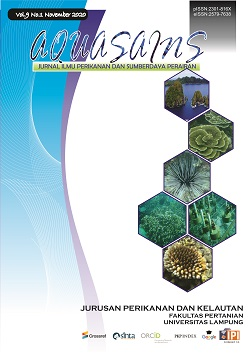Effect Utilization Mangrove Rhizophora Sp Fruit Extract in Production of Coffee Powder in Perspective of Water Content and Organoleptic Test
DOI:
https://doi.org/10.23960/aqs.v9i1.p881-886 Abstract View: 675
Abstract View: 675
Abstract
Utilization of mangrove seeds is not as popular the use of wood tree. Utilization of wood from mangrove tree is used as raw material for making charcoal and building materials.The local community rarely uses mangrove seeds for food, drinks, scrubs and coloring. This is not enough of public knowledge about the benefits of mangrove seeds. The public mindset that the only sources of carbohydrates are rice and corn. There is not much knowledge about the potential and benefits of mangrove seeds as a coffee drink. The research method used in this research is experimental research. In this experiment, 3 repetitions of treatment and 3 replications. Water content data in the mangrove seed ground coffee was tested by normality test. The proximate test results show ash content of 1 to 4% when averaged is 2.6%. While the general requirement for roasted coffee (SNI.01.2983-1992) is 7-14% ash content. The color of coffee is influenced by the value of the extract content of the coffee, water soluble coffee juice will give it a deep black color ( Pastiniasih, 2012). The juice content of magrove coffee is high enough for each treatment so that the steeping gives a visually visible black color.Downloads
Download data is not yet available.
Downloads
Published
2020-11-11
How to Cite
Sukma, R. N., & Zahro, M. (2020). Effect Utilization Mangrove Rhizophora Sp Fruit Extract in Production of Coffee Powder in Perspective of Water Content and Organoleptic Test. Aqusains: Jurnal Ilmu Perikanan Dan Sumberdaya Perairan, 9(1), 881–886. https://doi.org/10.23960/aqs.v9i1.p881-886
Issue
Section
Articles

.png)










